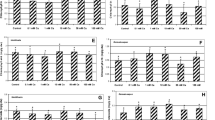Abstract
The lichen Evernia prunastri is very frequently employed in lichen biomonitoring studies and its sensitivity to air pollution has been confirmed at the community level many times. However, studies focused on the physiological responses of this lichen to pollutants are underrepresented. The degree of total as well as intracellular Cu uptake by the lichen after 4 and 24 h prolonged exposure was compared with selected physiological markers including levels of assimilation pigments, chlorophyll a fluorescence, ergosterol, soluble proteins, hydrogen peroxide, superoxide, amino acids, reducing sugars and total soluble phenols. Although the degree of total as well as intracellular Cu uptake by the lichen after 4 and 24 h prolonged exposure were comparable, metabolic responses after 4 and 24 h were very different. Carotenoids, ergosterol and soluble proteins decreased due to Cu exposure and these processes were followed with an increase of superoxide content. Excess of Cu in thalli of E. prunastri after 24 h was toxic and altered almost all tested parameters, including depletion of reducing sugars. We did not observe stimulation of free amino acid synthesis in Cu treated lichen, in fact the content of many particular amino acids decreased. Content of total soluble phenols was unaltered by Cu excess.


Similar content being viewed by others
Abbreviations
- Dw:
-
Dry weight
- PPFD:
-
Photosynthetic photon flux density
References
Bačkor M, Loppi S (2009) Interactions of lichens with heavy metals. Biol Plant 53:214–222
Bačkor M, Pawlik-Skowrońska B, Tomko J, Bud’ová J, Sanitá di Toppi L (2006) Response to copper stress in aposymbiotically grown lichen mycobiont Cladonia cristatella: uptake, viability, ergosterol and production of non-protein thiols. Mycol Res 110:994–999
Bačkor M, Váczi P, Barták M, Bud’ová J, Dzubaj A (2007) Uptake, photosynthetic characteristics and membrane lipid peroxidation levels in the lichen photobiont Trebouxia erici exposed to copper and cadmium. Bryologist 110:100–107
Bačkor M, Klejdus B, Vantová I, Kováčik J (2009) Physiological adaptations in the lichens Peltigera rufescens and Cladina arbuscula var. mitis, and the moss Racomitrium lanuginosum to copper-rich substrate. Chemosphere 76:1340–1343
Bačkor M, Péli ER, Vantová I (2011) Copper tolerance in the macrolichens Cladonia furcata and Cladina arbuscula subsp. mitis is constitutive rather than inducible. Chemosphere 85:106–113
Bradford MM (1976) A rapid and sensitive method for the quantification of microgram quantities of protein utilizing the principle of protein-dye binding. Anal Biochem 72:248–254
Branquinho C, Brown DH, Catarino F (1997) The cellular location of Cu in lichens and its effects on membrane integrity and chlorophyll fluorescence. Environ Exp Bot 38:165–179
Branquinho C, Catarino F, Brown DH, Pereira MJ, Soares A (1999) Improving the use of lichens as biomonitors of atmospheric metal pollution. Sci Tot Environ 232:67–77
Chettri MK, Cook CM, Vardaka E, Sawidis T, Lanaras T (1998) The effect of Cu, Zn and Pb on the chlorophyll content of the lichen Cladonia convoluta and Cladonia rangiformis. Environ Exp Bot 39:1–10
Conti ME, Tudino M, Stripeikis J, Cecchetti G (2004) Heavy metal accumulation in the lichen Evernia prunastri transplanted at urban, rural and industrial sites in Central Italy. J Atmos Chem 49:83–94
Feuerer T, Hawksworth DL (2007) Biodiversity of lichens, including a world-wide analysis of checklist data based on Takhtajan’s floristic regions. Biodivers Conserv 16:85–98
Garty J (2001) Biomonitoring atmospheric heavy metals with lichens: theory and application. Crit Rev Plant Sci 20:309–371
Hall JL (2002) Cellular mechanisms for heavy metal detoxification and tolerance. J Exp Bot 53:1–11
Kong FX, Hu W, Chao SY, Sang WL, Wang LS (1999) Physiological responses of the lichen Xanthoparmelia mexicana to oxidative stress of SO2. Environ Exp Bot 42:201–209
Kováčik J, Klejdus B, Bačkor M, Štork F, Hedbavny J (2011a) Physiological responses of root-less epiphytic plants to acid rain. Ecotoxicology 20:348–357
Kováčik J, Klejdus B, Štork F, Hedbavny J (2011b) Nitrate deficiency reduces cadmium and nickel accumulation in chamomile plants. J Agric Food Chem 59:5139–5149
Loppi S, Pacioni G, Olivieri N, Di Giacomo F (1998) Accumulation of trace metals in the lichen Everina prunastri transplanted at biomonitoring sites in central Italy. Bryologist 101:451–454
Monnet F, Bordas F, Deluchat V, Baudu M (2006) Toxicity of copper excess on the lichen Dermatocarpon luridum: antioxidant enzyme activities. Chemosphere 65:1806–1813
Pawlik-Skowrońska B, Sanità di Toppi L, Favali MA, Fossati F, Pirszel J, Skowroński T (2002) Lichens respond to heavy metals by phytochelatin synthesis. New Phytol 156:95–102
Pirintsos S, Kotzabasis K, Loppi S (2004) Polyamine production in lichens under metal pollution stress. J Atmos Chem 49:303–315
Purvis OW, Halls C (1996) A review of lichens in metal-enriched environments. Lichenologist 28:571–601
Rankovic B, Rankovic D, Manc D (2010) Antioxidant and antimicrobial activity of some lichen species. Microbiology 79:809–815
Ronen R, Galun M (1984) Pigment extraction from lichens with dimethyl sulfoxide (DMSO) and estimation of chlorophyll degradation. Environ Exp Bot 24:239–245
Sanità di Toppi L, Marabottini R, Vattuone Z, Musetti R, Favali MA, Sorgonà A, Badiani M (2005) Cell wall immobilization and antioxidant status of Xanthoria parietina thalli exposed to cadmium. Funct Plant Biol 32:611–618
Schützendübel A, Pole A (2002) Plant responses to abiotic stresses: heavy metal-induced oxidative stress and protection by mycorrhization. J Exp Bot 53:1351–1365
Wellburn AR (1994) The spectral determination of chlorophylls a and b, as well as total carotenoids, using various solvents with spectrophotometers of different resolutions. J Plant Physiol 144:307–313
Acknowledgments
This work was financially supported by Slovak Grant Agency (VEGA 1/1238/12) and Grant Agency of the Czech Republic (GA ČR 521/02/1367). Thanks are expressed to Kenneth Andrew Dvorsky M.Sc. M.Ed. (University of Toronto, Canada) for comments on the manuscript.
Author information
Authors and Affiliations
Corresponding author
Rights and permissions
About this article
Cite this article
Vantová, I., Bačkor, M., Klejdus, B. et al. Copper uptake and copper-induced physiological changes in the epiphytic lichen Evernia prunastri . Plant Growth Regul 69, 1–9 (2013). https://doi.org/10.1007/s10725-012-9741-z
Received:
Accepted:
Published:
Issue Date:
DOI: https://doi.org/10.1007/s10725-012-9741-z




